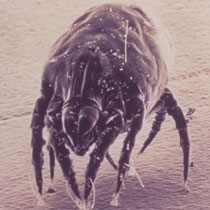House dust mites are found in most homes. They are microscopic, eight-legged creatures closely associated with us, but they are not parasitic and do not bite. They don’t burrow under the skin, like scabies mites or live in skin follicles, like skin follicle mites.

The concern about dust mites is people are allergic to them. Symptoms associated with dust mite allergies include sneezing, itchy, watery eyes, nasal stuffiness, runny nose, stuffy ears, respiratory problems, eczema and (in severe cases) asthma. Many people notice these symptoms when they stir dust during cleaning activities. But, dust also contains other allergens, including cat and dog dander, cigarette ash, cockroach droppings, mold spores and pollen.
How can you find out if you’re allergic to dust mites? An allergist, a medical doctor specially trained to treat allergies, should be consulted for proper diagnosis.
The dust mite allergen is their tiny feces and body fragments which are components of dust. These particles are so small they can become airborne and inhaled when dust is disturbed.
Biology:
These mites are so small they are virtually invisible without magnification. Female mites lay cream-colored eggs coated with a sticky substance so eggs will cling to the substrate. These mites have two distinct immature stages. Under optimal conditions, the entire life cycle from egg to adult takes three-four weeks.
House dust mites feed on human skin scales, pollen, fungi, bacteria and animal dander. Dust mites do not drink free water, but absorb water from the air and the environment.
To thrive, dust mites need very warm temperatures and high humidity levels — 70-80 percent relative humidity. One study showed when humidity is 60 percent or lower, the mite population stops growing and dies out.
We also spend about one-third of our lives sleeping so high levels of dust mites are often associated with the bedroom, especially bedding and the mattress. Dust mites also eat animal dander so allergens will be plentiful in areas where family pets sleep.
Dust Mite Management:
To eliminate dust mite allergens, first, take actions to reduce dust mite populations and second, reduce exposure to dust. No one method has been found for reducing mites and relieving allergy suffering.
LOWER HUMIDITY —Reduce humidity levels to less than 50 percent inside your home, especially in the bedroom. This isn’t hard to do in the winter, but can be a challenge in Nebraska during summer months, especially in homes without air conditioning. Studies have shown air-conditioned homes have ten times fewer dust mite allergens than non-air-conditioned homes. In addition to cooling the house, air conditioning reduces the humidity dust mites need to thrive. A study has shown using an electric blanket for eight hours each day reduced dust mites by 50 percent in one month.
AVOID FURRY OR FEATHERED PETS — Pets with fur or feathers contribute to the dander in the dust and increase food source for mites. If you are a pet lover, locate their sleeping quarters as far from yours as possible and furnish their sleeping area so it can be cleaned easily. Hardwood or vinyl floors with washable area rugs are ideal.
REDUCING AIR INFILTRATION — Airing out the house with open windows allows entry of pollen, which is another allergen as well as food for dust mites. In some climates, incoming air may be humid, which promotes dust mites.
CLEANING/HEAT TREATMENTS — Wash all bedding weekly. Research has shown laundering with any detergent in hot water removes nearly all dust mite and cat allergen from bedding. If you cannot launder blankets, dry clean them once a year. Shampoo, steam clean or beat non-washable carpets once a year.
SELECT APPROPRIATE FURNISHINGS — Avoid overstuffed furniture because it collects dust. Also avoid wool fabrics/rugs because wool sheds particles and is eaten by other insects. Use washable curtains and rugs instead of wall-to-wall carpeting. If you cannot replace carpeting, have it steam cleaned at least once a year, springtime is best. This will prevent a build up of dust mites feeding on skin cells in the carpet during the summertime. Enclose mattresses and pillows in plastic to decrease mite populations in the bed. Replace feather pillows with synthetic ones.
Dust Management:
Eliminating dust from the environment is important in reducing allergens in sensitive people.
VACUUMING — The most important tool for managing house dust and dust mites is the vacuum cleaner. Regular, thorough vacuuming of carpets, furniture, textiles and other home furnishings such as draperies will help keep dust mite populations low. Vacuums with a water filter are preferable to those with a disposable paper bag because a water vacuum removes a greater range of particle sizes than paper-bag types. There are vacuums with highly efficient filters (HEPA) designed for use by people with allergies to dust. It is better to vacuum thoroughly once a week rather than lightly on a daily basis. Vacuum mattresses and padded furniture thoroughly; 20 minutes for each mattress is not too long.
DUSTING — Dust furniture before you vacuum so the dust has time to settle on the floor, where it can be picked up by the vacuum. Do not scatter dust. Instead, dust with a damp cloth rather than dry dusting. Spraying furniture polish/dusting liquid directly on surface reduces airborne particles by 93 percent compared with dry dusting.
AIR PURIFERS — A HEPA air filter is much more effective at removing dust than ion-generating air purifiers which make particles electrically charged to remove them from circulating air.
The problem with ion-generating air filters is they emit significant amounts of ozone. Ozone irritates the lungs and can cause chest pain, coughing, shortness of breath and throat irritation. Ozone is a toxic gas with vastly different chemical and toxicological properties from oxygen.
More facts about Dust Mites in Ireland:
- Beds are a prime habitat (where 1/3 of our life occurs). A typical used mattress may have anywhere from 100,000 to 10 million dust mites inside.
- Ten percent of the weight of a two-year old pillow can be composed of dead dust mites and their droppings.
- The dust mite’s Latin name translates as ‘skin-eating spider’
- A favourite food of dust mites is dander (both human and animal skin flakes). Humans shed about 1/5 ounce of dander (dead skin) each week or about a gram of skin per day.
- Dust Mites prefer warm, moist surroundings such as the inside of a mattress when someone is on it.
- Dust mites, due to their very small size (250 to 300 microns in length) and translucent bodies, are not visible to the unaided eye.
- We fill our lungs up to 20,000 times each day. Over time, contaminants can cause allergies, inflammation of the mucous membrane, upper respiratory problems, asthmatic conditions, headaches and flu-like symptoms.
- Approximately 85% of asthmatics are allergic to dust mites.
- The National Academy of Sciences Institute of Medicine reports that exposure to indoor pollutants is a key contributor to asthma problems.
- During their life span a dust mite will excrete about 200 times its own body weight.
